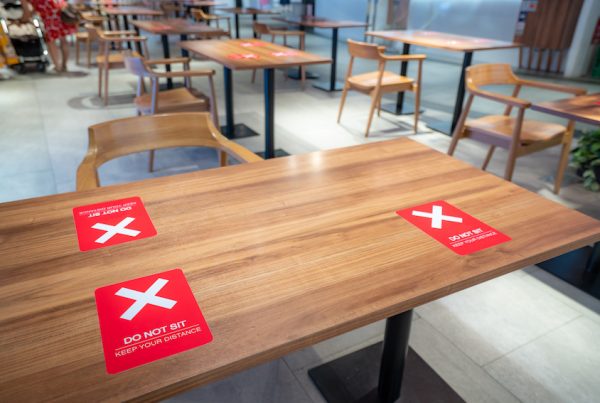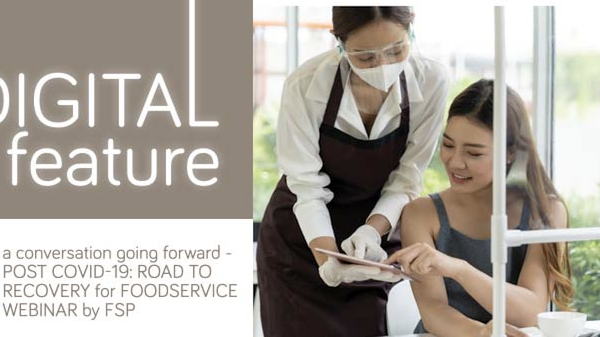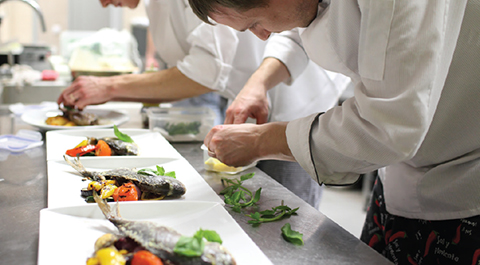
Now that you’ve been familiarised with the origins of Standard Operating Procedures (SOPs), let’s take a look at the different types of SOP. Before that however, let’s break down the various types of food service and establishments.
TYPES OF FOODSERVICE
Restaurants
Satisfies the objective of provision of food and drinks, generally at a higher price with high levels of service, which grew out of hotel restaurants through chefs wishing to start their own business.
Casual Dining
Used to be known as popular catering – including cafes, pizza, grills, specialist coffee shops, steak houses etc with the objective of provision of food and drinks generally at low/medium prices with limited levels of service.
Fast food
Refers to the provision of food and drink in a highly specialised environment, characterised by high investment, high labour costs and vast customer throughout. This type of food service is heavily influenced by American companies and sophisticated meal packaging and marketing.
Take-Away/Delivery
An umbrella of fast food would be take-away service which include delis or other type of casual dining, referring to the quick provision of food and drinks. Increasingly, due to rapid urbanisation – the food delivery sector is becoming very popular – especially among Millennials.
Looking at each establishment will help to hone in on focus areas. For instance, It’s important to single out the type of service each establishment provides, so if a restaurant is compared to say, casual dining, customers would expect a higher level of service at restaurants, thus the business owner needs to be comprehensive in his/her SOP planning when it comes to service. Have a think about how varied the procedures would be, and whether or not the operations involve a central kitchen, for example. In that case, variables to do with transportation and temperature would play a role in your SOPs.
BREAKING DOWN THE COMPONENTS
In order to understand different components of SOPs, it would be helpful to identify the variables in F&B operations. These variables can be divided into three sections:
- Organisational
Service methods, legislative controls, billing methods, auditing methods, marketing or merchandising, control method costs and revenue, provisioning and storage methods, production methods, clearing methods, dishwashing methods, type of equipment, dining arrangements, nature of market, range of choice, style of menu/drinks list, staff working hours, staff organisation, number of staff, opening times/service period, scale of operations, seating time, number of covers available and capacity
- Performance Measures
Seat turnover/customer throughout, customers spend/average bill, revenue per member of staff, ratio of food and beverage sales to total sales, productivity index, sales/profit per square meter or feet/per seat, sales analysis, departmental profit, stock turnover, stock holding
- Customer Experience
Food and drinks available, price range/value for money, atmosphere factors such as décor, lighting, air conditioning, acoustics, noise, size and shape of room, type of crowd, attitude of staff and cleanliness and hygiene
SOPs are all about quality assurance, which is linked to cleanliness and safety, whether personal or food. As such, your SOPs should revolve around the four pillars discussed in the first article – Quality, Cleanliness, Personal Safety and Food Safety.
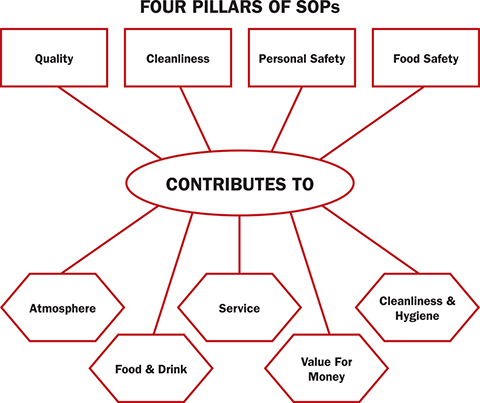
SOPs IN THE BACK AND FRONT
The categories of SOP can be divided into:
- Kitchen
usually referred to as Back of House and pertaining to any procedures and steps undertaken in a commercial kitchen
- Service
usually referred to as Front of House and pertaining to any and all interactions with the establishment’s guests
- Operations
this includes both Back and Front of House and encompasses the day-to-day running of a restaurant
Based on these categories, the SOPs for each are broken down in the same manner. The SOPs listed below are meant to shed some light on the different SOPs, according to the category.
SOPs IN THE KITCHEN
The following samples illustrated below are standard procedures that must be developed to ensure consistency of the products. These checklists combined will act as a simplified procedure for any employee to use to ensure products produced have the following:
- Standard Portioning
- Same Appearance
- Same Texture
- Same Flavour
- Same Size
This process must be completed and updated on a regular basis together with menu engineering to achieve minimum variance.
The same applies to the serving of beverages – in order to reduce cost and be as standardised as humanly possible, it would be good practice to print out recipes for each and every drink on your menu.
SOPs ON CLEANLINESS AND HYGIENE
The quickest way to contaminate food products in the kitchen is by neglecting personal hygiene, and this is why most chefs are very particular about how their team maintain their personal hygiene. Even one hair out of place can cause a potential catastrophe that could easily be avoided by following SOPs.
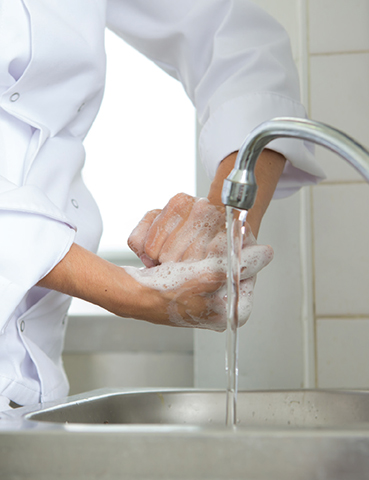
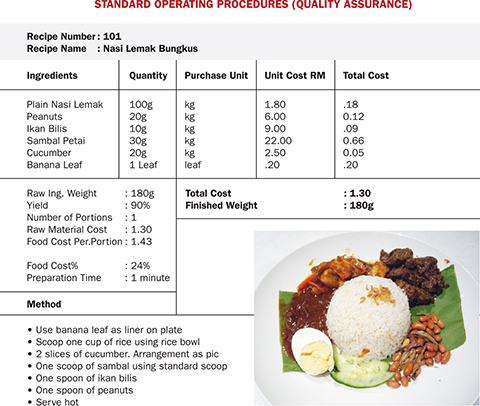
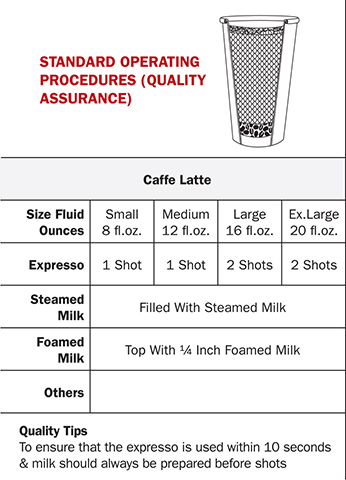
SOPs FOR SERVICE
Customer satisfaction and service procedures are critical to the success of the business.
professionally. While you may not be able to obtain 100% adherence to every SOP, as a general rule of thumb, your staff will follow in your footsteps and learn by example on how to treat and serve guests. Also, it’s impor tant to decide the level of ser vice you plan to have in your restaurant, based on the type of establishment you have. For instance, if you own a fast-food outlet, there will be less emphasis on service, whereas if you’re running a full-scale restaurant, your service should be of utmost priority, along with the quality of food.
Sample List Of SOPs For Greeting Your Customers

-
- All customers will be acknowledged within 30 seconds of arrival with eye contact, a warm friendly smile & a verbal greeting. Where possible the customer will be acknowledged by name.
- Ascertain the customer’s number of persons & check on availability of table & also their preferences.
- All customers will be escorted to their tables, satisfaction checked with the location & chairs pulled where applicable (ladies given priority).
-
All guests will be offered the menu, specials of the day explained & missing items clarified.
Service Staff Responsibilities

-
- All staff will always be clean, presentable & in full uniform.
- All customers’ queries will be answered knowledgeably and tactfully by all staff.
- Staff will always speak clearly in low controlled voices & never shout or yell in the restaurant.
- Service will be fast & friendly to both internal & external customers.
- Staff must be attentive yet as un-obstructive as possible to the customers.
- All staff must attend pre-service briefings conducted by the supervisor or manager on duty before the beginning of service.
Your Service Area

- The table will always be clean, uniform and set to specifications.
- Operating equipment will always be clean, wellarranged and easily accessible.
- All service areas will be maintained in a clean & hygienic condition with a clean & inviting ambiance.
- Background music within the restaurant must be at an un-obstructive level and clear with no hiss.
SOPs ON OPERATIONS
The operations of an F&B establishment encompass the day-to-day practices that keep the wheels moving along. SOPs for a restaurant’s operations would include items such as SOPs on procuring supplies, opening and closing SOPs, financial auditing SOPs and more. These sort of SOPs are usually performed by the General or Restaurant Manager at F&B establishments, assisted by the servers and overseen by upper management. In smaller establishments, you might see the owner conducting these steps. It’s important to look at the entire operations as a whole – from procuring, stock-keeping, bookkeeping to keeping up with health and safety regulations and then breaking them down into manageable steps.
Here is an example of an opening flowchart that can be used across the board:
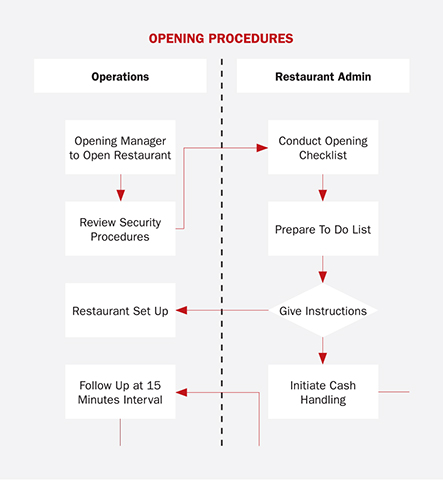
A Note on Sustainability
The other thing to consider is to implement the United Nation’s Sustainable Development Goals into your business. While it is popular now to claim that a restaurant’s food is organic and that its ingredients have been procured sustainably, most people forget that sustainability can be implemented into your entire operations, from top to bottom, as well as in your SOP. Have a look at the relevant info on UN’s website to find out more.








